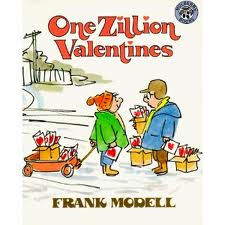Mrs. McCall’s class participated in a Valentine Storytime this week. The lesson began with two different story rhymes about 
 valentines. Next the children matched valentines illustrated with rhyming words. Three stories about showing affection followed: How Do Dinosaurs Say I Love You? by Jane Yolen, Happy Valentine’s Day, Mouse! by Laura Numeroff, and One Zillion Valentines by Frank Modell. The lesson ended with the children cutting out folded paper hearts and using them to make valentines to give to others.
valentines. Next the children matched valentines illustrated with rhyming words. Three stories about showing affection followed: How Do Dinosaurs Say I Love You? by Jane Yolen, Happy Valentine’s Day, Mouse! by Laura Numeroff, and One Zillion Valentines by Frank Modell. The lesson ended with the children cutting out folded paper hearts and using them to make valentines to give to others.
Valentine storytime
Conversation Hearts
 This week’s contest was an estimation contest. Participants were asked to guess the number of “Conversation Hearts” in the estimation jar. There were 477 colored candy hearts. No one guessed the exact amount, but fourth grader Ashton was the closest with his estimate of 489 hearts. Ashton wins a heart-shaped bowl.
This week’s contest was an estimation contest. Participants were asked to guess the number of “Conversation Hearts” in the estimation jar. There were 477 colored candy hearts. No one guessed the exact amount, but fourth grader Ashton was the closest with his estimate of 489 hearts. Ashton wins a heart-shaped bowl.
Chickadee Award update
Due to snow days, early dismissals, and a holiday, some classes have missed a lesson featuring a Chickadee Award nominee. This week was “catch up” week.
Now all the kindergarten classes have heard and seen Step Gently Out by Helen Frost and Rick Lieder. The text is a poem about insects and the illustrations are amazing close-up photographs of eleven different insects. Before reading the book, the insects were introduced one at a time. The children recognized some of the insects, but many were unfamiliar to them. Next, Mrs. Miliano read the book. Then she went back through the book and, together, the children identified the insects. An insect sorting activity followed. Each child picked a plastic insect out of a can. The first time, they sorted their insects by type (dragonfly, ant, ladybug, or caterpillar) and counted the number in each group to determine which had the most. Then they sorted their insects by color (red, yellow, and blue) and counted each group to determine which was largest.
Big6 in February
 In February we are focusing on Stage 4 of the Big6 information problem solving model: Use of Information. At this stage, the student engages with information on his/her topic. Commonly, that means the student reads text, but it can also mean the student listens to a lecture or views a video. The second step is to extract the needed information. This is probably the most difficult step of the whole process! The student has to determine what is relevant and record the information in note form in a graphic organizer of some type. He/she must also cite the source of the information. Here’s how students practiced Stage 4: Use of Information during their monthly library lesson:
In February we are focusing on Stage 4 of the Big6 information problem solving model: Use of Information. At this stage, the student engages with information on his/her topic. Commonly, that means the student reads text, but it can also mean the student listens to a lecture or views a video. The second step is to extract the needed information. This is probably the most difficult step of the whole process! The student has to determine what is relevant and record the information in note form in a graphic organizer of some type. He/she must also cite the source of the information. Here’s how students practiced Stage 4: Use of Information during their monthly library lesson:
Miss Miliano’s first graders investigated capybaras (the world’s largest rodent). Together they read/listened to the article about capybaras in PebbleGo’s Animals database. They selected facts to be  recorded on a graphic organizer in the categories of appearance, food, habitat, and interesting facts. Afterwards, the students each selected one note about capybaras and wrote it as a sentence on an illustrated worksheet.
recorded on a graphic organizer in the categories of appearance, food, habitat, and interesting facts. Afterwards, the students each selected one note about capybaras and wrote it as a sentence on an illustrated worksheet.
Mrs. Sullivan’s second graders investigated the African country of Malawi. They gathered information about Malawi’s location, population, food, and wildlife from the website “Our Africa: Malawi.” The facts were recorded on a graphic organizer that compared Malawi to the United States. The children learned that life in Malawi is very different than their own!
Mrs. Labbe’s third graders are learning about nonfiction text features such as timelines, charts, tables, bold words, glossaries, and indexes. Soon they will undertake a biography project. They will research a  famous person and write a biography about him/her. Their writing will include some of the text features they have been learning about. In their Big6 lesson, the concept of plagiarism and how to avoid it was introduced. The students were taught to take notes by reading one sentence at a time and recording the keywords and/or phrases in a bulleted list. They read the biography of author/illustrator Tomie dePaola in PebbleGo’s Biographies database and worked together to collect information that could be used in a timelines life. At the end of the lesson, the students compared their notes with the timeline in the article and were pleasantly surprised to see how closely they matched!
famous person and write a biography about him/her. Their writing will include some of the text features they have been learning about. In their Big6 lesson, the concept of plagiarism and how to avoid it was introduced. The students were taught to take notes by reading one sentence at a time and recording the keywords and/or phrases in a bulleted list. They read the biography of author/illustrator Tomie dePaola in PebbleGo’s Biographies database and worked together to collect information that could be used in a timelines life. At the end of the lesson, the students compared their notes with the timeline in the article and were pleasantly surprised to see how closely they matched!
Mrs. Meehan’s fifth graders have just started studying Ancient Egypt. Soon they will begin working on an ABC book about the topic. They will select one person, place, or thing related to the ancient civilization for each letter of the alphabet. They will investigate the topic in books or online and write three sentences about it and locate three images to go with the information. They will create their ABC books as slide  presentations in Keynote. In their library lesson, the assignment was examined in light of the first three stages of the Big6. Then note-taking was introduced and practiced with an encyclopedia article (from Encyclopedia Britannica through MARVEL) about the Egyptian god Re. The children were taught to record only the keywords and/or phrases in bulleted list to avoid plagiarism. How to cite books and webpages was also introduced.
presentations in Keynote. In their library lesson, the assignment was examined in light of the first three stages of the Big6. Then note-taking was introduced and practiced with an encyclopedia article (from Encyclopedia Britannica through MARVEL) about the Egyptian god Re. The children were taught to record only the keywords and/or phrases in bulleted list to avoid plagiarism. How to cite books and webpages was also introduced.
Time for a story
 Storytime for Mrs. McCall’s class focused on telling time. The featured nursery rhyme was “Hickory Dickory Dock” and the story was Time To… by Shapleigh author/photographer Bruce McMillan. The children traced the numerals on a paper clock face, cut out the circle, and glued it on a paper plate to make clocks.. A long, narrow triangle of paper was attached to the center of the clock face with a brad in order to allow the students to change the time on their clocks. What is it time to do? Read a story!
Storytime for Mrs. McCall’s class focused on telling time. The featured nursery rhyme was “Hickory Dickory Dock” and the story was Time To… by Shapleigh author/photographer Bruce McMillan. The children traced the numerals on a paper clock face, cut out the circle, and glued it on a paper plate to make clocks.. A long, narrow triangle of paper was attached to the center of the clock face with a brad in order to allow the students to change the time on their clocks. What is it time to do? Read a story!